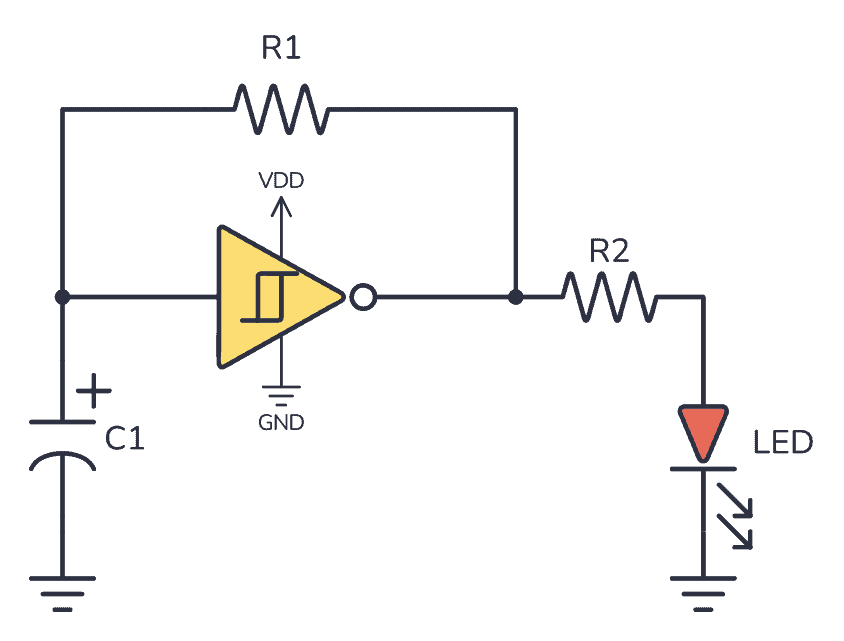Features:
- Six Schmitt-trigger inverters for stable and noise-free output
- Wide operating voltage range: 3V to 15V
- High noise immunity
- Low power consumption
- Wide operating temperature range: -40°C to +125°C
- Easy to use with minimal external components
Principle of Work:
Each inverter in the 40106 switches its output based on two distinct threshold voltage levels, ensuring stable transitions. Logic high input produces a logic low output, and logic low input produces a logic high output.
Pinout:

| Pin Number |
Pin Name |
Description |
| 1,3,5,11,13,15 |
Schmitt Input Pins |
Input pins of the Schmitt trigger |
| 2,4,6,10,12,14 |
Schmitt Inverted Output Pins |
Output pins of the Schmitt trigger |
| 7 |
Ground |
Connected to system ground |
| 14 |
Vcc |
Positive power supply |
Applications:
- Wave and pulse shapers
- Astable and monostable multivibrators
- Noise removing circuits
- Debouncing circuits
- Hysteresis controllers
- Dead band filters
Example Circuit:
Oscillator blinking an LED at about 1Hz using 40106, 9V battery, 100µF capacitor, two 10kΩ resistors, and LED.

Technical Details:
- Schmitt Trigger – Hex Inverter
- Operating Voltage: 5V
- Low-Level Hysteresis Voltage: 0.3V
- High-Level Hysteresis Voltage: 3.5V
- Output Current High: -1mA
- Output Current Low: 1mA
- Quiescent Current: 40nA
- Propagation Delay: 280ns
- Operating Temperature Range: -55°C to +125°C
Comparisons:
Compared to the 74HC14, the 40106 supports a wider supply voltage (3V to 15V vs 2V to 6V) and offers higher input impedance, while the 74HC14 provides lower output impedance and higher speed. Both provide six Schmitt-trigger inverters.
Features:
- Six Schmitt-trigger inverters for stable and noise-free output
- Wide operating voltage range: 3V to 15V
- High noise immunity
- Low power consumption
- Wide operating temperature range: -40°C to +125°C
- Easy to use with minimal external components
Principle of Work:
Each inverter in the 40106 switches its output based on two distinct threshold voltage levels, ensuring stable transitions. Logic high input produces a logic low output, and logic low input produces a logic high output.
Pinout:

| Pin Number |
Pin Name |
Description |
| 1,3,5,11,13,15 |
Schmitt Input Pins |
Input pins of the Schmitt trigger |
| 2,4,6,10,12,14 |
Schmitt Inverted Output Pins |
Output pins of the Schmitt trigger |
| 7 |
Ground |
Connected to system ground |
| 14 |
Vcc |
Positive power supply |
Applications:
- Wave and pulse shapers
- Astable and monostable multivibrators
- Noise removing circuits
- Debouncing circuits
- Hysteresis controllers
- Dead band filters
Example Circuit:
Oscillator blinking an LED at about 1Hz using 40106, 9V battery, 100µF capacitor, two 10kΩ resistors, and LED.

Technical Details:
- Schmitt Trigger – Hex Inverter
- Operating Voltage: 5V
- Low-Level Hysteresis Voltage: 0.3V
- High-Level Hysteresis Voltage: 3.5V
- Output Current High: -1mA
- Output Current Low: 1mA
- Quiescent Current: 40nA
- Propagation Delay: 280ns
- Operating Temperature Range: -55°C to +125°C
Comparisons:
Compared to the 74HC14, the 40106 supports a wider supply voltage (3V to 15V vs 2V to 6V) and offers higher input impedance, while the 74HC14 provides lower output impedance and higher speed. Both provide six Schmitt-trigger inverters.


